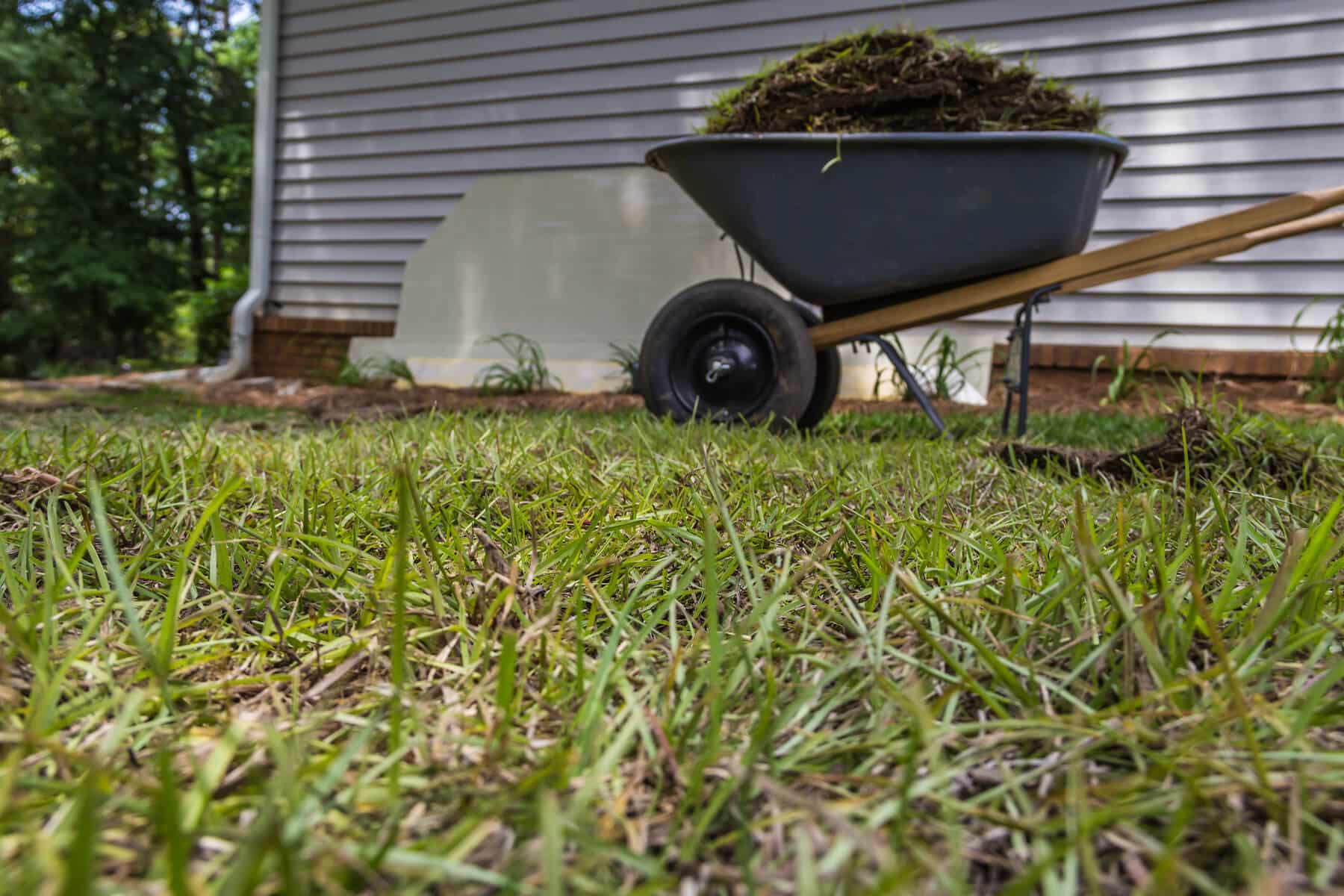Centipede Grass
Centipede Grass, like any type of grass, has both its pros and cons. Before deciding if this is the right type for your space, here is some important information to help you make the best decision for you.

Some Facts About Centipede Grass
Centipede Grass is native to Southeast Asia and China but was introduced to the States in 1916.
Today, it is found mostly in the region from South Carolina to Florida and then westward spanning the Gulf Coast states all the way to Texas. This is the type of climate it is best suited for.
One of the main reasons Centipede Grass is a popular choice is because it is low maintenance. Yet this grass’s expansion westward has been limited due to severe iron deficiencies that tend to develop in the alkaline soil found in the more arid regions.
Because Centipede grass is better suited for warmer climates, this has hindered its ability to move north. Some More Facts to consider are:
This type of grass is best suited for sandy, acidic soils.
It is also ideal for areas that get more than 40 inches of rainfall annually.
It can tolerate soil with low fertility levels and thrives in soil with moderate fertility levels. Because Centipede Grass does not have a period of dormancy, it can be severely damaged during cold spells.
This choice for grass is best suited for residential lawns as well as golf courses, parks, and utility turf. However, it is not ideal for areas with heavy traffic. Keep this in mind if you are planning for an athletic field or know your residential yard would get a high amount of use.
Characteristics & Traits
Aside from the low maintenance requirements, another reason Centipede grass is popular is its ability to adapt to low fertility conditions.
This also includes an ability to survive and even thrive in the sandy, acidic soils that the southern U.S. region is known for.
Although this type of grass does not do well in cold temperatures, it is still more cold tolerant than St. Augustine Grass. Centipede Grass is recognizable by its coarse texture. It is also a perennial grass, which means it continues the growth cycle on its own without the need for replanting each year.
Although this grass is started by seed, it spreads by stolons.
A stolon is also known as a runner. These are creeping plant stems that run horizontally and then take root at certain points along the length. These points then form new plants. Centipede Grass is usually found to be yellow green in color.
- This grass type is also known for forming a dense turf. Its rate of growth is slow compared to other types of grass.
- Centipede Grass is commonly nicknamed the “lazy man’s grass” because it requires little maintenance. In fact, it requires less maintenance than even St. Augustine or Bermuda grasses.
- Although Centipede grass remains green all year long, its leaves and young stolons are killed by hard freezes. This grass does not have a dormant state and will continue or resume growth when the temperatures allow for it. However, it is more prone to be sensitive to iron deficiency.
- The leaf blades are flat and rounded at the base.
- Centipede Grass stolons are thin and branching. The blades of the leaf are usually up to 30 mm long and 2-4 mm wide.
- The sheaths overlap for this type of grass.
- Although Centipede Grass is fairly tolerant of shade, it still does best with full sunlight exposure. What can truly harm Centipede Grass are periods of hard freezes. Too many repeat freezes deplete the energy from this type of grass.
The result is that even once the warmth of spring sets in, the grass is left in a weakened state. For this reason, Centipede Grass does not do well in colder climates or even areas that get too many freezes during the winter.
Where Did It Come From & What Are The Varieties?
Centipede grass was actually first introduced to the United States in 1916.Frank N. Meyer collected the seed for this grass from South China, and from there,it flourished in the southern part of the U.S. This grass can also be found in South America, the West Indies, and along certain locations of Africa’s west coast.
In the United States, it can now be found basically wherever St. Augustine Grass has been adapted as well. Although Centipede Grass is better for adaptation to cooler weather than Bermuda and St. Augustine, it is similar to St. Augustine in that it’s less tolerant of heavy traffic.
There have been some adaptations made that are meant to withstand heavier traffic, but nothing has proven to be as successful as using a different type of grass that can handle traffic well.
Varieties of Centipede Grass created include:
- Oklawn: This variety of Centipede Grass was the result of work from Oklahoma State University and was released in 1965. It is more tolerant of both cold temperatures and droughts.
- Tennessee Hardy: As the name might imply, this variety of Centipede Grass was the creation of the University of Tennessee. The best trait of this variety is how hardy it is in its ability to withstand cold weather.
- AU Centennial Centipede Grass: Auburn University developed this semi-dwarf variety in 1983. It has shorter internodes so the result is denser and lower growing sod. The shortened seedheads also improved the appearance.
Advantages & Disadvantages
Advantages
- Centipede Grass requires less maintenance than many other types of grass.
- This grass choice also does well in the sandy, acidic soils that cover the Southern U.S. states.
- It also adapts well to low fertility conditions, so it can survive easier than some other types of grass.
- Although Centipede Grass is not cold tolerant, it still does better than St. Augustine Grass for cooler temperatures.
- If properly managed, this type of grass also holds up well against pests.
- It remains green late into fall and turns green early in spring.
Disadvantages
- If not properly maintained, pests can still pose a threat to Centipede Grass.
- Any hard freezes will kill leaves and young stolons of this type of grass.
- It is fairly tolerant of shade but is best suited for areas that get full sunlight exposure.
- Centipede Grass is not as tolerant to salt as St. Augustine or Bermuda grasses.
- Supplemental iron applications may be required to help Centipede Grass survive in areas with a pH above 70.
- This option for grass is also not ideal for any locations that get heavy traffic or need to take abuse, like an athletic field.
- Centipede Grass also does not handle drought conditions well.
Establishment & Maintenance
The three ways that Centipede grass can be established are:.
- SEED
- SOD
- SPRIGS
With the seed planting, success is highly dependent on the preparation of the seedbed. Soil must first be properly rototilled or disked. It can also first be pulverized by a rake or rotovator. Then it must be leveled and packed firmly with a roller.
The seeds should be distributed by spreader or hand. Mix together 1/3 seed with a gallon of fine sand for best distribution. However, if you are using this for plantings larger than 1,000 square feet, it is best to use a grass drill; then the sand will not be needed.
Once the seeds have been planted, you should firm the site with the roller and then water lightly. For the next two to three weeks you should keep the seedbed damp but not wet or soaked. If you cannot keep the site wet because of the size, then you should wait for planting until the conditions allow for soil moisture.
Fertilizer during planting can also improve the chances of success. If all is done correctly, you should be able to enjoy full coverage within a three-month time span.
Using sod plugs or springs is a little different. These should be planted about a foot apart and in rows. Keep in mind that establishing Centipede Grass through sprigs requires about the same amount of care as starting from planting seeds, at least for the first 14 days.
Sod plugs are ideal for those who cannot or don’t want to put in as much effort. However, they still require regular watering during the first few weeks. For any of the three choices, you can expect coverage within about three months.
Watering, Mowing & Pest Management
As mentioned previously, Centipede grass is known as the “lazy man’s grass.” In other words, there is not much involved in the maintenance of this type of grass.
The main requirements for Centipede Grass are mowing and watering as needed and annual fertilization. The fertilization is just to help prevent severe wilting.
Do not make the mistake of using too much nitrogen. Many homeowners use this to improve color and stimulate growth. However, this will actually cause future problems with the grass even though it does improve color and growth.
This type of grass is shallow rooted.Because of this, it is important to make sure the watering is managed well during summer months.
Although Centipede Grass is somewhat drought tolerant, it is not as much so as other types of grass choices. If your lawn shows signs of water stress, such as wilting and discoloration, then water should be applied.
Also, if you use light and frequent watering, you will end up with even more shallow roots. The sandier the soil, the more frequently you will need to water your Centipede Grass.
In some cases, Centipede Grass may develop chlorotic conditions. If so, you will need to use applications of potassium to correct the problem temporarily. You also may need to apply iron on a monthly basis in order to promote a greener hue.
The main concern is weed control. Apply herbicides during the fall or winter to help prevent this issue. This will help to improve the appearance and allow for less frequent mowing.
Crabgrass is the most common issue in the summer. Again, using herbicides in the early spring will help prevent this problem.
As for pests, the most common problems are:
- beetles
- crickets
- grass hoppers
- worms
- millipedes
These pests can feed on either the blades or the roots. They can usually be controlled with soil insecticides and natural products. If you’re looking for a low maintenance grass and your environmental conditions are a good fit, then Centipede Grass may be the best choice for your lawn.







